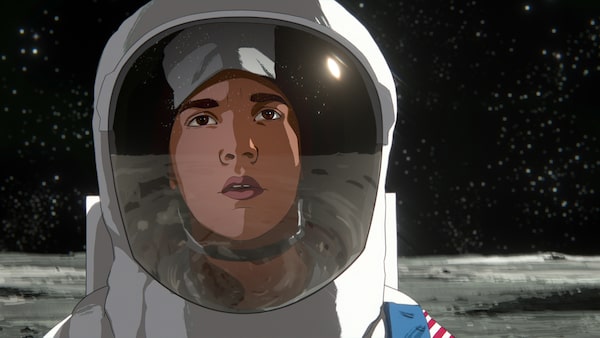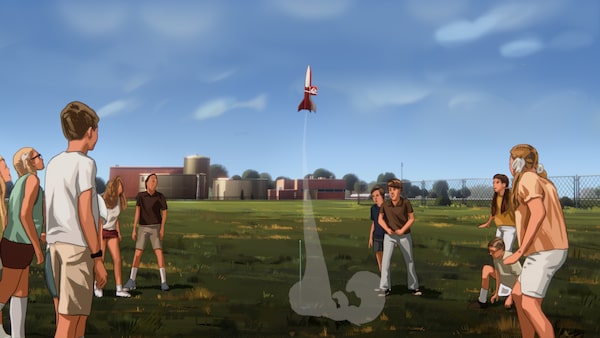
Apollo 10 ½: A Space Age Childhood tells the story of the first moon landing in the summer of 1969 from two interwoven perspectives.Netflix
Plan your screen time with the weekly What to Watch newsletter. Sign up today.
Apollo 10 ½: A Space Age Childhood
Written and directed by Richard Linklater
Starring Jack Black, Milo Coy
Classification N/A; 98 minutes
Opens at Toronto’s TIFF Bell Lightbox and Vancouver’s VIFF Centre on March 25; streams on Netflix starting April 1
After the first men landed on the moon on July 20, 1969, Walter Cronkite paused to consider the many implications of what had just happened. He wondered about the astronauts and their abilities to relate the otherworldly moment to others. “It may not be a beauty that one can pass on to future beholders,” the newscaster said. “They will, in effect, be a bit stranger, even to their own wives and children – disappeared into another life that we can’t follow.”
What astronauts such as Neil Armstrong haven’t been able to pass on to us mere earthlings, filmmakers have attempted to fill in. Moon movie highlights over the years include Ron Howard’s Apollo 13 in 1995, Damien Chazelle’s First Man from 2018, and Todd Douglas Miller’s excellent archival doc Apollo 11 in 2019.
Now here’s Richard Linklater, whose animated Netflix fantasy-drama Apollo 10 ½ is more time capsule than space capsule, and too nostalgic by half. The boy protagonist is Stan (voiced by Milo Coy), an admitted fabulist whose story involves a top-secret trip to the moon. By mistake, the lunar landing module was built too small. Stan is recruited for the mission because of his compact size, his aptitude in science and the ability to speak the English language better than a chimpanzee.
The school kid is a version of Linklater, who grew up in the 1960s in Houston, the place of the Astrodome and the National Aeronautics and Space Administration. Does Linklater treat the space age adoringly? You bet your NASA he does.
Linklater, whose Dazed and Confused from 1993 was a love letter to his Texas teenage years of the 1970s, is every bit a child of the sixties. Apollo 10 ½ is a voyage back to the dawning of the Age of Aquarius and his own coming of age. His self-assigned mission is to pass on the era’s hope, purpose and pop culture to today’s beholders.
Apollo 10 ½ doesn’t dwell on the boy-in-space story. Rather, half the film at least is a crash course in late sixties zeitgeist and Americana. The history is narrated by adult Stan (voiced by Jack Black). It’s a look back at a white-bread suburban upbringing and family life. Think The Wonder Years meets King of the Hill.
At one point, an exhaustive list of television series are rattled off – everything from Dark Shadows to Bewitched to Beverly Hillbillies. After catching his breath, the narrator then adds (either ridiculously or sarcastically), “to name a few.”
Though the Saturday morning ritual of cartoon watching is noted, there’s no mention of The Jetsons, Hanna-Barbera’s vision of the space age of the future. As for the animation aesthetic of Apollo 10 ½, Linklater went with a mix of hand-drawn and digital techniques. Handsome, but not fancy, it matches the analog vibe of the era Linklater is so clearly taken with.

Taking inspiration from filmmaker Richard Linklater’s own life, Apollo 10 ½: A Space Age Childhood is a snapshot of American life in the 1960s that is part coming of age, part societal commentary and part out-of-this-world adventure.Netflix
Linklater is a serious retro-music dude. Here he spaces us out with Astronomy Domine and Shape of Things to Come, but stays clear of the period-perfect (but predictable) Space Oddity.
The nostalgia quotient might be indulgent overload for some, though catnip for others. Linklater does capture the once-in-a-lifetime uniqueness of the era, whether with the poetically momentous on-air dialogue of Cronkite and Eric Sevareid, or with the portrayal of children living carefree while cities burned, leaders were being assassinated routinely and wars raged hot and cold.
This was a time when science fiction was coming to life – “an optimistically technological future.” The film presents the wonderment and shared sense of accomplishment. “Wow,” the mother says, watching the moon-walk moment on television with her gleeful family. Maybe technology is taken for granted today – where are our “wow” moments now?
The telephone conversation between president Richard Nixon and the astronauts is recreated. “For one priceless moment in the whole history of man all the people on this Earth are truly one,” Nixon says. “One in their pride in what you have done and one in our prayers that you will return safely to earth.”
The moment of “one” didn’t last though. When the kids go to bed before the moon-landing broadcast was over, the father is incredulous. But the daughter explains: “It’s over,” she says.
It really was.
Plan your screen time with the weekly What to Watch newsletter, with film, TV and streaming reviews and more. Sign up today.
 Brad Wheeler
Brad Wheeler